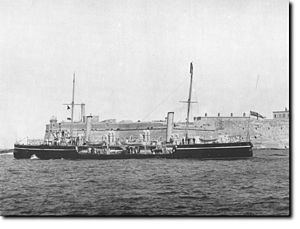Name HMS Harrier Commissioned 8 July 1896 Construction started 21 January 1893 Length 80 m Displacement 970,700 kg Builder Devonport Dockyard | Laid down 21 January 1893 Beam 30 ft 6 in (9.3 m) Launched 20 February 1894 Weight 1,087 tons Draft 4 m | |
 | ||
Fate Sold for commercial use in 1920 Class and type | ||
The sixth HMS Harrier was a Dryad-class torpedo gunboat. She was launched at Devonport Dockyard on 20 February 1894, and saw service in the Mediterranean and in fishery protection. She served as a minesweeper during World War I and was sold for commercial use in 1920.
Contents
Design
Ordered under the Naval Defence Act of 1889, which established the "Two-Power Standard", the class was contemporary with the first torpedo boat destroyers. With a length overall of 262 ft 6 in (80.01 m), a beam of 30 ft 6 in (9.30 m) and a displacement of 1,070 tons, these torpedo gunboats were not small ships by the standard of the time; they were larger than the majority of World War I destroyers. Harrier was engined by Hawthorn Leslie and Company with two sets of vertical triple-expansion steam engines, two locomotive-type boilers, and twin screws. This layout produced 3,500 indicated horsepower (2,600 kW), giving her a speed of 18.2 knots (33.7 km/h). She carried between 100 and 160 tons of coal and was manned by 120 sailors and officers.
Armament
The armament when built comprised two QF 4.7-inch (12 cm) guns, four 6-pdr guns and a single 5-barrelled Nordenfelt machine gun. Her primary weapon was five 18-inch (450-mm) torpedo tubes, with two reloads. On conversion to a minesweeper in 1914 two of the five torpedoes were removed.
Mediterranean service
Lieutenant and Commander Philip Walter was appointed in command in July 1897, during her first commission, which was spent on the Mediterranean Station. She left Port Said for Malta on 8 February 1900, and on 24 March 1900 paid off at Devonport. Commander Cyril Everard Tower was appointed in command on 11 March 1901, following which she again returned to the Mediterranean Station, and in late November 1901 replaced the Mariner-class gunvessel Melita as the special service vessel at Constantinople. She visited the Danube in early 1902, and was ordered to the Persian Gulf on special service in June that year.
Fishery protection and tender to the Navigation School
She spent some time before World War I engaged in fishery protection duties and was for a time a tender to the Navigation School.
Conversion to a minesweeper
At the outbreak of war she was converted at Portsmouth, in common with most of the rest of her class, to the minesweeping role.
Disposal
She was sold to T R Sales at Haulbowline, Cork on 23 February 1920 for commercial use.
